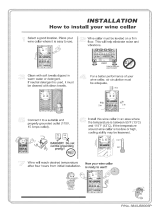
Safety and warnings
Safety and warnings
To reduce the risk of re, electric shock, or injury to persons, please read the IMPORTANT
SAFETY INSTRUCTIONS before operating this appliance. Use this appliance only for its intended
purpose as described in this User Guide.
Important!
When using this appliance, always exercise basic safety precautions including the following:
This appliance is not intended for use by persons (including children) with reduced physical,
sensory or mental capabilities, or lack of experience and knowledge, unless they have been given
supervision or instruction concerning use of the appliance by a person responsible for their safety.
Risk of child entrapment. Before you throw away your old refrigerator, freezer or Wine Cellar:
– Take o the door.
– Leave the shelves in place so that children may not easily climb inside.
Do not operate your Wine Cellar in the presence of explosive fumes.
Extreme care must be taken when disposing of your old appliance to avoid hazards. The
refrigerant gas must be safely removed and for the safety of young children, remove doors.
Your Haier Appliances Authorised Service Centre will be able to give advice on
environmentally friendly methods of disposing of your old Wine Cellar.
This appliance must be properly installed in accordance with the installation instructions before
it is used.
Never unplug your Wine Cellar by pulling on the power cord.
Always grip the plug rmly and pull straight out from the outlet.
Repair or replace immediately all electric service cords that have become frayed or otherwise
damaged. Do not use a cord that shows cracks or abrasion along its length at either the plug or
appliance end.
If the power supply cord is damaged, it must only be replaced by your Haier Appliances
Authorised Service Agent.
When moving your appliance away from, or against the wall, be careful not to crush or damage
the power cord.
Unplug your Wine Cellar before cleaning, replacing the light bulb, or making any repairs.
This Wine Cellar should not be recessed or built-in to an enclosed cabinet. It is designed for
freestanding installation only.
Ensure your appliance is positioned free of any obstructions that will prevent air from owing
around the cabinet sides.
Do not store food in the Wine Cellar. The interior temperature will not be cool enough to prevent
spoilage in food and will promote bacterial growth.
Many commercially available cleaning products contain solvents which may attack plastic
components of your Wine Cellar and cause them to crack.
Please refer to the cleaning care section of this booklet for further advice.
SAVE THESE INSTRUCTIONS
2
Children should be supervised to ensure that they do not play with the appliance.















